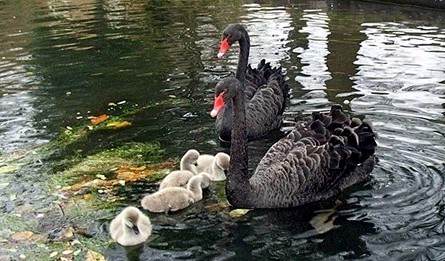
The future of our black swans
by Rex Needle

The future of our black swans
by Rex Needle
|
The trustees of Bourne United Charities have cancelled their order for two new black swans to inhabit St Peter’s Pool in the Wellhead Gardens (in April 2014) following recent stories that several have been killed over the years by predators or even marauding dogs that have not been kept under control by their owners. This may be a premature decision based on a petition to ban these birds in the future even though it has attracted only forty signatures but in no circumstances do the vociferous few represent a majority and it is hardly a reflection of public opinion in a town with a population currently in excess of 15,000. In addition, those who have signed may not be fully cognisant with the facts of the case while the trustees seem to have been influenced in their decision by the emotive headlines about the deaths of these birds in our local newspapers which at no time have reported on the restrictions required in keeping them. Nevertheless, Trevor Hollinshead, speaking for Bourne United Charities, told The Local newspaper (April 25th) that “the trustees had taken note of public opinion” and had stopped an order for two new swans. He added: “We will wait and find out what the people really want.” Black swans were introduced to St Peter’s Pool in 1999 and have since become an icon for Bourne and a magnet for visitors, although over the years several have been killed, sometimes by foxes although dogs and vandals have also been blamed. They are less aggressive than our native white or mute swans and this may well be a contributory factor in these cases. The dead birds have always been replaced and this has been the intention following the latest loss earlier this year. Strict rules apply to the keeping of these birds as outlined in 2005 by the Royal Society for the Protection of Birds which cited new government regulations that required anyone in charge of non-native species to ensure that they do not escape. This includes our own black swans and their cygnets which are therefore pinioned to prevent them from flying off and breeding in the wild which would upset the balance of nature in this country and although bird lovers may not approve because it restricts their movement when attacked, it does appear to be a wise precaution. The protestors have claimed that the wings of the bird are "pinned" but the correct term is pinioned, that is the act of surgically removing one pinion joint, the joint of a bird's wing furthest from the body, to prevent flight, a normal practice among waterfowl and poultry. This is always done when the bird is at a young age and if carried out correctly by a veterinarian or by a trained breeder then there are no ill effects. The current restrictions governing the keeping of black swans apply equally throughout the United Kingdom and we know of no case where they are being refused because of it. They are, therefore, in danger wherever they live in this country and yet this petition, however well intentioned, would set Bourne apart in its rejection of these birds whereas they are here to stay and so must live somewhere. If there is to be a realistic petition then perhaps rescinding the current regulations that require black swans to be pinioned might be a suitable target or a campaign to send all black swans back to Australia from whence they came to live unhindered, neither of which would win much support. As it is, the black swans have become ubiquitous in this part of the world and we must do the best for them that we can under the restraints in force. It is impossible to guard against all eventualities in life, especially when it involves animals and birds in a natural environment, and perhaps the trustees when considering whether to keep them as a most popular attraction at St Peter’s Pool where they have been for the past fifteen years should not only test public opinion much further than the current petition but also, and more importantly, decide whether having more birds, complete with pinioned wings, is a risk worth taking. The black swans are handsome birds with dark, curly plumage, bright red bills and white wing feathers that show only in flight. They are indigenous to Australia and Tasmania and were at times hunted to near extinction but were brought to Europe by the Dutch in the 17th century when they were regarded with amazement. Since then, they have become a popular ornamental bird and there are many breeding pairs in this country, particularly at Dawlish in Devon where a colony has become so well established that the bird has been the town's emblem for the past forty years. They are, then, welcome in other parts of Britain and by denying them a home at St Peter’s Pool we will be making them outcasts in an island where they have been welcome for over 300 years. The charity trustees have to make a final decision but one that should not be too difficult for them because it is basically one of common sense.
NOTE: This article was published on the Bourne web site |
![]()
Go to: Main Index Villages Index